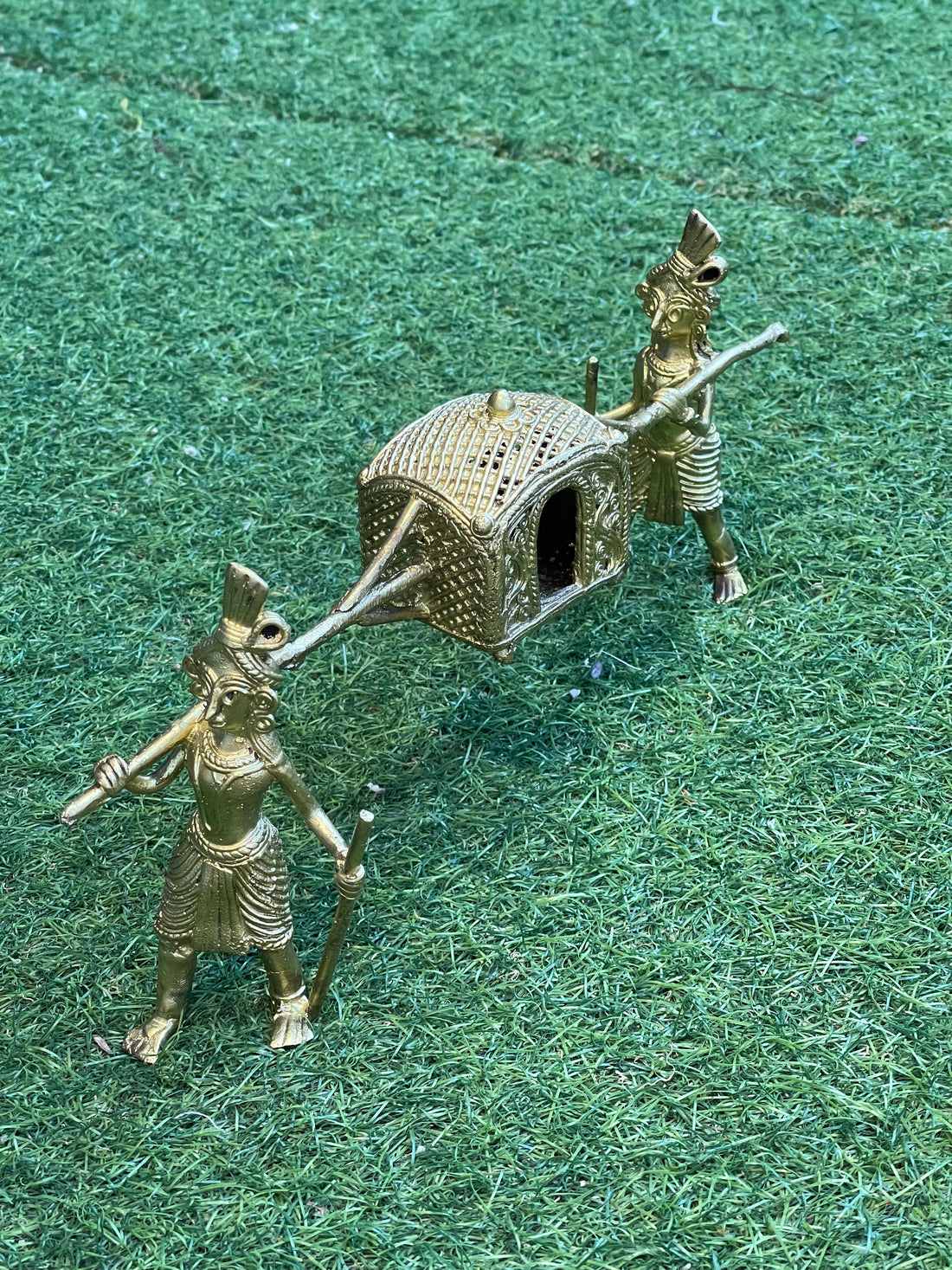Dokra craft
By Bina Jeyabalan
Commissioned by Handpicked
You, Me and Dokra
There are these metal figurines that look like a wire has been twisted, curled, and looped around to create them. They are strangely familiar with the touch of mystery. Familiar, because we have seen them somewhere or the other. Mysterious, since we don’t know what the charm of these not-so-shiny and not-so-perfect items are. Now these, are the Dokra Artefacts.
Though they look like it has been made with a long thick wire, it is in fact a joint-less metal casting technique that uses the not so lost – Lost wax Technique. The infamous dancing girl from Mohenjo-Daro from our textbooks was one of the earliest examples of the Lost Wax technique. Incidentally, the Lost Wax technique is also referred to as the Lost Mold technique.
Theory of Dokra craft
Very few changes in the process have been made in the lost wax technique in the last 6000 years. A brief look into the process:
- A clay core (with a mix of clay and rice husk) is made keeping the shape of the final design in mind. It needs to dry for a day.
- A mix of bee’s wax, resin, nut oil, and/or tar is used to make a soft malleable dough. It is then made into long strips and strands.
- This is coiled around the clay core to the desired shape and structure of the final figure.
- The finer details are added to the designs using the wax strands.
- This wax mold is covered with different layers of clay and let to dry. A small hole is drilled for the wax to drain out later.
- Once the outer clay mold is dried, it is placed in the furnace.
- Molten metal is poured into it and the melted wax drains out. Hence we have the name Lost Wax Casting since the original wax model is destroyed to create the art piece.
- This is allowed to cool and the outer clay mold is then gently and sometimes not so gently broken open with a small hammer/chisel. Hence the not-so-popular name of - The Lost Mold technique is also appropriate.
- The pieces are then cleaned and polished.
The uniqueness of this process ensures the distinctive quality of every single Dokra artefact. The Dokra technique is handed down through generations in different tribes and is a labour-intensive process.
The first thing that stood out for me in the Dokra metal crafts is that there are no pieces alike. They just aren’t. The technique the Dokra art form follows is such. An order of a 100 small camels for a corporate goody bag means that a 100 wax camels are made by the artisan, a 100 molds are made and broken. The process ensures the exclusivity of each piece.
Philosophy of Dokra designs
While the Dokra art technique is fascinating, the creativity and the designs are what grabs our attention. The Dokra art has a distinctive wire-like look about it. Many of the designs seen in Dokra art are from nature and from everyday life.
Dokra has its roots in ancient peoples and represents a primitive lifestyle. The beliefs of people go back to the age of hunting. This is seen in the prevalent designs which include - miniature figurines of animals, mythical characters, tribal people, drummers, folks portraying daily chores, Gods, and Goddesses.
The Dokra art sold by the nomadic Metal-smith tribes ‘Dhokra Damar’ in Bengal were considered auspicious and greatly revered.
Tribal art is primitive, simple, and never ‘perfect’. The human body is portrayed having thin hands and thin legs on a slender body that is not proportionate – these reflect a history of its own. Simplicity mixed with intricate work and designs is the beauty of Dokra.
Dokra craft lends itself to the smallest of entwined beads to lofty figures. Dokra designs have embraced themselves to a mix of modern aesthetics and contemporary designs. A primitive simplicity with an elegance that grounds us. This is Dokra Art and Craft.
Whatever our reasons for picking up a piece of Dokra, we invite a sense of timelessness into our lives.
Dokra Revival
100 years ago, a Dokra craftsman earned as much as an accountant but is sadly not the case today. The art has endured, transformed, and grown in the last 6000 years and continues to do so. Keeping the art alive was a conscious and determined effort by individuals, our government, non-profit agencies, businesses, and patrons throughout the ages.
There is a sharp decline in the demand for the Dokra craft. The various heritage losses that have happened over the centuries, many known and many unknown can cause a deep sense of loss and regret.
We can, however, arm ourselves with the knowledge and value the depth of the art available at hand. We can keep it relevant and keep it in our lives.
Dokra Regions
Dokra art is a way of life in many communities in Madhya Pradesh, Chhattisgarh, Odisha, Jharkhand, West Bengal, and Telangana. The various tribal belts have their own workmanship and styles, while the technique remains the same.
Now that we are armed with some Dokra knowledge, let’s make some dinnertime conversations informational and fun.

About the product:
Dokra, brass drummer set.
A design from the ages that captures movement, rhythm, and beauty. You definitely don’t have to listen too hard to hear the sounds of the drum beat.

About the Product
Dokra Paisleys Neck Piece with colourful beads
This is one of the evolutions of the Dokra art. It uses a combination of craft forms from Odisha. Simple, elegant, contemporary, and timeless. It will fashion itself to the traditional you or to your avant-garde self.

Brass Dokra Spiral Hooks Earrings
These adorable Dokra spiral earrings keep the heart of the art form intact while adding charm. A piece of history, a piece of culture, a dextrous twist of the artisan, and a piece of you. All of it in these adorable Dokra earrings.

Avid Book Reader – Brass Dokra Craft
Everyday chores in Dokra craft is an oft-seen scene. It truly is wonderful to see the book reader, depicted through the eyes of the Dokra craftsmanship and we can surely hope we get time to read every day. We see the lanky body depiction that is true to the tribal art form here.
About the author:
Bina Jeyabalan is a freelancer who enjoys research writing as much as writing her bleets (Bleets are a bizarre combination of Blogs and Tweets). You can find her covered in various forms of dough or batter – depending on the time of day. It could be the artisan bread dough or a flavourful spiced cake batter or the fermented dosa batter.
Armed with an Undergrad and Postgrad degree in Finance, dabbling as an Entrepreneur, home-baker, and writer while being a full-time-stay-at-present mom of three – she definitely rolls with the punches.
Please reach out to her for any of your writing needs and check out her fun blogs and bleets below.
www.binajeyabalan@blogspot.com
Email: bina_jb@hotmail.com
Sources
- “Dokra metal crafts” 10, Aug. 2022 http://www.telanganatourism.gov.in/partials/about/arts-crafts/dokra-metal-crafts.html
- Prabhala, Lakshmi. “Adilabad:: Dhokra” Published 18, May, 2016 Accessed 9, Aug. 2022 https://floatstheboat.wordpress.com/2016/05/18/adilabad-dhokra/
- Mokashi, Akshata, “Dhokra: Metal Casting and its Harappan Connection Published 26 Feb 2021 Accessed 9,Aug. 2022 https://www.livehistoryindia.com/story/living-culture/dhokra-art
- “The process of Making Dhokra Products” Accessed 10, Aug, 2022 https://artsandculture.google.com/story/the-process-of-making-dhokra-products-dastkari-haat-samiti/kAUBNhtpqUgiIg?hl=en
- Bajpai, Suman, “Dhokra Art is a Sustainable Tribal Legacy.” India Currents, 14, June 2021, Accessed Aug. 2022 indiacurrents.com/dhokra-art-is-a-sustainable-tribal-legacy/
- “Dokra Metal Craft” 14,Jan. 2017 Accessed on 10, Aug, 2022 https://www.telangana360.com/2017/01/dokra-metal-craft.html
- “Dhokra” 10, Aug. 2022 https://en.wikipedia.org/wiki/Dhokra

